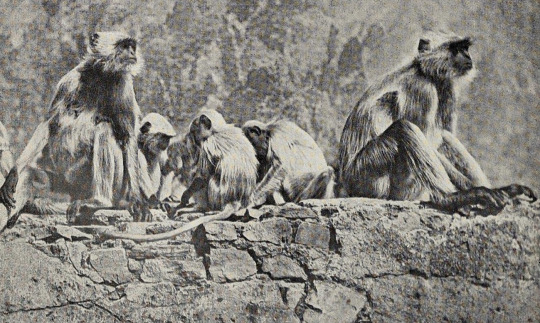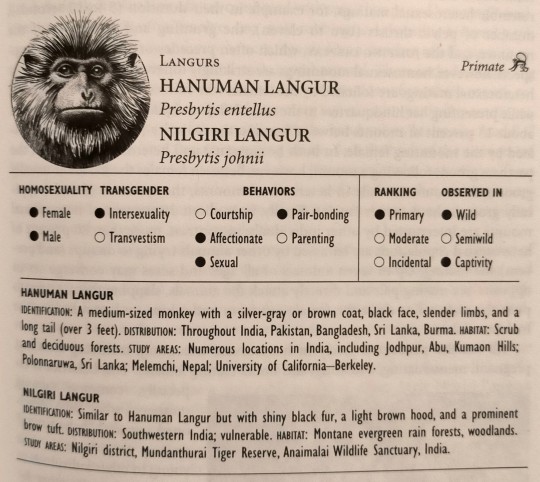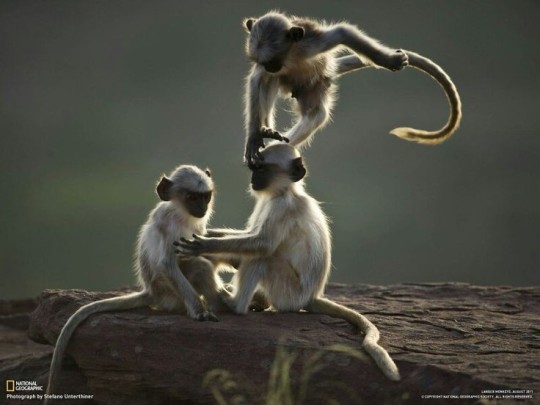#hanuman langur
Text

Taxidermy Hanuman langur
By: Unknown photographer
From: The Journal of Heredity
1910
23 notes
·
View notes
Text
From September 8, 2023, in 09 Satlok ashrams, the followers of Jagatguru Tatvdarshi Sant Rampal Ji Maharaj are going to celebrate the 73rd incarnation day with great enthusiasm. All of you along with family are cordially invited in this Bhandara made from pure desi ghee. Along with free storage, there is also a very good arrangement for parking for vehicles coming from outside, which will be free of cost.

2 notes
·
View notes
Photo

Grey Langur
#grey langur#gray langur#hanuman langur#langur#Primates#Haplorhini#Simiiformes#Cercopithecidae#Colobinae#Presbytini#Semnopithecus#upl
2 notes
·
View notes
Text
All females participate freely in homosexual mounting, including lactating, pregnant, menstruating, ovulating, and nonovulating females.

A female Hanuman Langur in India mounting another female
"Biological Exuberance: Animal Homosexuality and Natural Diversity" - Bruce Bagemihl
#book quotes#biological exuberance#bruce bagemihl#nonfiction#hanuman langur#presbytis entellus#homosexual#lesbian#mounting#lactating#pregnant#menstruating#ovulating#nonovulating
3 notes
·
View notes
Text
0 notes
Text
In addition, young females from one group sometimes "kidnap" a baby from a neighboring group, keeping the infant for up to 33 hours before its mother is able to retrieve it.
"Biological Exuberance: Animal Homosexuality and Natural Diversity" - Bruce Bagemihl
#book quote#biological exuberance#bruce bagemihl#nonfiction#hanuman langur#presbytis entellus#kidnapping
0 notes
Text
All female Hanuman Langurs participate in homosexual activity, to varying degrees; most females are probably bisexual, also mating heterosexually to a greater or lesser extent. Male Hanuman Langurs are probably sequentially bisexual, since each male spends some part of his life in an all-male band, where homosexual activities typically occur – and at any given time, as much as 75-90 percent of the male population may be living in such bands.
"Biological Exuberance: Animal Homosexuality and Natural Diversity" - Bruce Bagemihl
#book quote#biological exuberance#bruce bagemihl#nonfiction#hanuman langur#presbytis entellus#homosexual#bisexual
0 notes
Video
youtube
Hanuman Langur / Sacred Monkey / Northern Plains Grey Langur At Mysore...
#youtube#Langur#Hanuman Langur#Sacred Langur#Northern Plains Gray Langur#Primates#Old Word Monkeys#Monkeys#Black Face#Grey Body#Mane Round Face#Long Tail#Native To Indian Sub-continent#Indian Animals#Stay On Trees & Ground#Common Langurs#Animals#Hebivore#Mammals#Mysore Zoo#Animals In Mysore Zoo#Hair On Body
0 notes
Photo

#langurs #graylangurs #old-world #monkey #londonzoo #zsl *London #conservation #wildlife #animals #nature #India #hanuman (at London Zoo) https://www.instagram.com/p/Ci4tUZlKLlt/?igshid=NGJjMDIxMWI=
0 notes
Text

Hanuman langur
By: Charles Reid
From: Brehms Tierleben
1922
7 notes
·
View notes
Photo

Hanuman langurs grooming dog Mandore garden, Jodhpur, India, 2019 - by Mark MacEwen, English
214 notes
·
View notes
Text
Hanuman Langurs live in cosexual troops (some contain only one male) and also in all-male groups. (...) Nilgiri Langurs live in both cosexual troops (usually eight to nine monkeys each, with one or two males) and same-sex groupings (usually two or three males, occasionally more, constituting about a quarter to a third of the adult males).

"Biological Exuberance: Animal Homosexuality and Natural Diversity" - Bruce Bagemihl
#book quotes#biological exuberance#bruce bagemihl#nonfiction#hanuman langur#presbytis entellus#nilgiri langur#presbytis johnii
0 notes
Note
Your characters are so adorable 🥰 What made you decide on a crested black macaque and a Hanuman langur as your OCs?

Thank you! For Lilac's species, it was the famous "monkey selfie" of a crested black macaque that inspired me. The moment I saw it, I fell in love with this species and began researching it. I was amazed by these monkeys' sensitivity and calm, friendly behaviour. They're now my favourite primates 🐒 As for Connor's, it was a bit more random; I was very undecided at first. One day I was flipping through an illustrated primate guide, saw the Hanuman langur and decided that would be Connor! I was looking for a large species that could fit the "fun-loving & dynamic" type I had in mind for him and I think this one does!


12 notes
·
View notes
Text
Intersexual Hanuman Langurs also occur: for example, anatomically male animals with female chromosomes (XX) have been documented.
"Biological Exuberance: Animal Homosexuality and Natural Diversity" - Bruce Bagemihl
#book quote#biological exuberance#bruce bagemihl#nonfiction#intersex#hanuman langur#presbytis entellus#chromosomes
0 notes
Text
Many inventive theories attempt to explain why ovulatory signals disappeared in the human line, but none of them, in my opinion, propose an advantage so sterling that it offsets the abandonment of the premier genereplicating method used by millions of species over millions of years—females signaling males their sexual readiness at the same moment they are ovulating.
The few species of primates that do not ostensibly signal ovulation are distant from the human line on the evolutionary primate-branching bush. A few other species' females also do not appear to advertise their ovulation—for example, some birds, such as mallards—but the problem of knowing for sure is exacerbated by the fact that human observers can't ask the males of these species whether or not they are aware of the females' ovulation.
Among the more ingenious explanations for why sexual signaling disappeared in humans is the one proposed by anthropologist Nancy Burley. Women lost the ability to monitor their ovulatory moment, according to Burley because those who grasped the connection between sex and pregnancy realized that pain, possible death, and taxing demands were also part of the deal.
A woman so enlightened, Burley theorizes, might prudently decide to abstain from sex . Celibates do not leave offspring. Selection pressure would, therefore, favor those women who were unaware of their ovulation.
Primatologist Sarah Blaffer Hardy proposes that infantile murder coaxed human cryptic ovulation into being in a theory known as the “many fathers.”
Having carefully documented the horrifying fact that male primates some¬ times killed infants, Hardy posits that the loss of external signs of ovulation ultimately protected newborns by keeping all parties guessing concerning the issue of paternity especially males. Unsure whether an infant was due to his copulatory efforts, a male would be less inclined to kill it.
Hardy worked primarily with hanuman langurs, but other studies, including Jane Goodall's chimpanzees in the wild and Alison Jolly's ring-tailed lemurs, have confirmed that males commit infanticide in these species. To date, thirty-five species of primates have been identified in which strange males kill infants.
Social scientists Margo Wilson and Martin Daly found suggestive evidence that this abhorrent practice exists among humans. Surveying crime statistics, they noted that when an adult male murders a child he is sixty-five times more likely to be a stepfather or live-in boyfriend than the child's biological father.
Though I have great respect and admiration for Hardy's work, I wonder whether her theory is the whole story If infanticide was so great a threat to the continuation of affected primate species, why did only the human line adopt the evolutionary strategy of cryptic ovulation to solve the problem?
Chimpanzees, for whom infanticide is a serious problem, have not evolved anything resembling cryptic ovulation. Bonobo males have never been observed to engage in killing infants, yet bonobo female primates come closest to mimicking the human female's reproductive model of loss of estrus and increased sexual receptivity.
The observation that strange males do the killing is in keeping with evolutionary theory. Alpha maledom often does not last very long. A strange male who achieves dominance must make hay while the sun shines. By killing the sucklings of his new group, he can precipitate estrus among the distressed mothers and thus increase his chances of spreading his genes.
Among human populations, it has been a common strategy of conquering armies, after beheading the losing side's warriors, to turn their attention to killing the infants who the conquerors know were fathered by those warriors. This slaughter of the innocents has been amply recorded at different times in disparate locales throughout history. Cryptic ovulation has rarely protected infants of the conquered women from being killed by strangers.
If keeping the male uncertain concerning paternity increases the life span of children, what would be the advantage to the female of remaining in the dark on such a vital issue as her own ovulation?
Another question: The male primates that engage in the practice of infanticide do not seem to care one fig about the offspring they do sire. Since the majority of infanticide is carried out by recently arrived males that are strangers to the group, it would be safe to assume that these animals are equipped with an instinct to kill the infant of any strange female.
Hardy's theory rests on the assumption that a male primate is capable of making the causal connection between sex and birth, either instinctually or consciously. There is minimal scientific evidence to indicate that this quantum leap in logic has occurred in the mind of another species besides a human.
Another problem: Since knowing when a female ovulates is critical to a male's fitness, why did not the human male develop a compensatory counteradaptation to detect the female's ovaries' subterfuge?
Many other theories abound. Donald Symons suggests women use their year-round sexual receptivity to seduce philanderers in exchange for gifts . L. Benshoof and Randy Thornhill propose that cryptic ovulation allows a woman to mate by stealth with a superior man without alerting her husband.
Though the theories outlined above may have been contributing factors in reprogramming Gyna sapiens ’reproductive cycle, they do not seem to offer sturdy enough reasons to explain the origin of such drastic changes in her life strategy.
The rarity of concealed ovulation among the other three million sexually reproducing species suggests that cryptic ovulation is not a mainline solution to any of the problems posed by the various theories.
The primary consequence of cryptic ovulation—the need for increased sexual contact to coincide with ovulation's propitious moment—would appear to be highly disadvantageous, evolutionarily speaking.
In the cold calculus of energy conservation, copulation is both dangerous and a very expensive metabolic activity An ancestral couple in flagrante delicto would have been very vulnerable to a predator. Sex consumes time, calories, resources, and mental effort that might better be used for survival. With a few notable exceptions, other creatures expend minimal time and energy copulating. The mating act of most birds and mammals can be measured in seconds.
The human investment, in terms of time spent thinking about sex, planning, wooing, and actually engaging in the act, exceeds that of any other creature. After their strenuous coitus, humans generally require a longer recovery interval than any other animal.
Additionally without a visible or olfactory lodestar, men and women have found it necessary to engage in frequent, capricious copulations throughout the year to increase the likelihood of pregnancy.
The uncertainty of conception, both for those who yearn for it and those who don't, has been among men's and women's most consistent causes of stress, anguish, and anxiety down through the generations.
Evolutionary processes do not care whether an organism is happy or not. Nevertheless, stress tends to diminish an organism's fitness.
Nonestral females of other species, with rare exception, do not appear to begrudge the attentions estral females receive from excited males. When Gyna sapiens lost estrus and gained the ability to engage in sex anytime throughout the year (if she so desired), the nettlesome problem of sexual jealousy among women reared its ugly head.
The green-eyed monster consumes a staggering waste of spirit and is virtually unknown among other species.
Cryptic ovulation and year-round sexual receptivity also greatly increased the amount and degree of jealousy among many men.
Societies have had to construct draconian legal, social, religious, and cultural barriers to regulate members' sexual competition and minimize the outbreak of violence. Duels, dogmas, eunuchs, taboos, so-called honor killings, chastity belts, and female genital mutilation are just a few of the rituals and devices that attest to the difficulty men have had in dealing with women's robust sexual capability.
Desmond Morris in his book The Naked Ape makes the argument that humans are the first species to elevate sex to the status of a recreational activity’ Morris speculates, “The vast bulk of copulation in our species is obvi¬ ously concerned, not with producing offspring, but with cementing the pair bond by providing mutual rewards for the sexual partners ."
According to this argument, endorsed by many others besides Morris, we are Homo ludens (the Playful Ape) and we have liberated sex from the depths of the Minotaurean labyrinth! in the brain's primitive limbic system of instinctual drives.
By elevating sex to the brain's higher, neocortical planes, according to these authors, we have created a new kind of sex. Proponents argue that the pleasure we so derive and the love that enhances the deep human commitments more than offsets any of the disadvantages of drastic changes in sexual programming.
2 notes
·
View notes